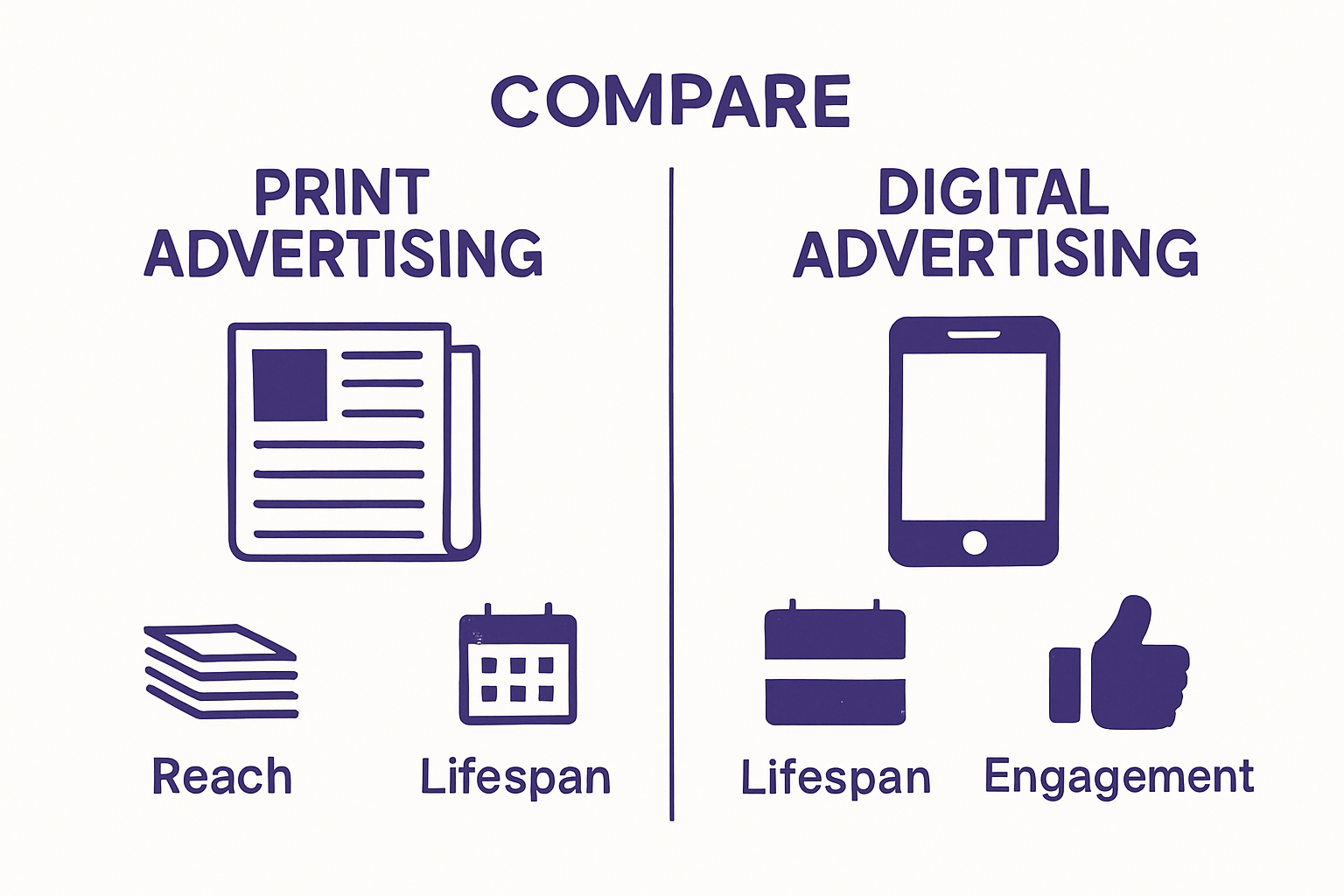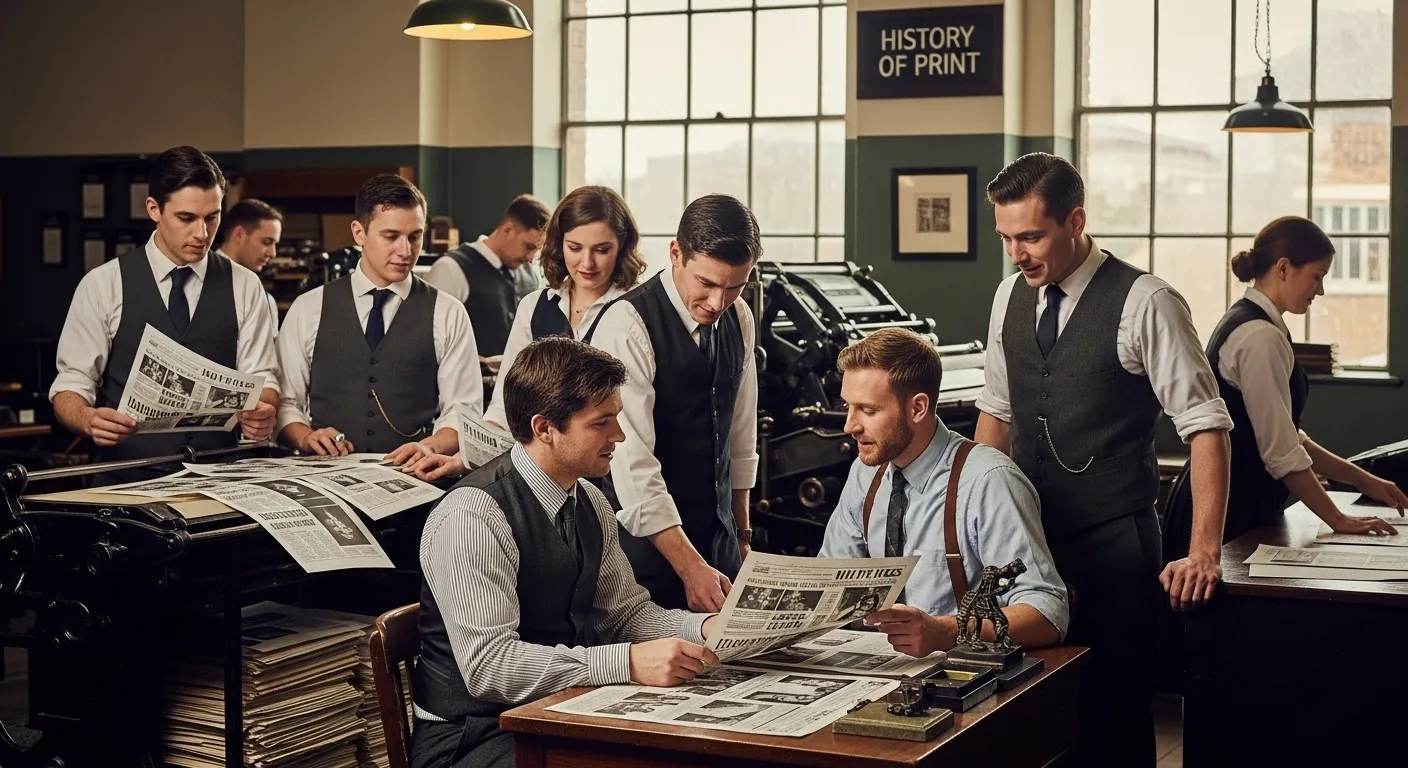Print advertising might sound old school in a world buzzing with digital ads and viral videos. But numbers tell a different story. More than 70 percent of consumers say they trust print advertisements over online ads. That kind of trust is not just rare in marketing, it is priceless. While everyone chases the next big thing on their screens, print keeps quietly shaping buying choices in ways digital often cannot touch.
Table of Contents
- The Evolution Of Print Advertising: Key Milestones
- Importance Of Print Advertising In Marketing History
- How Print Advertising Shapes Consumer Behavior
- Innovations In Print Advertising And Their Impact
- The Future Trends Of Print Advertising
Quick Summary
| Takeaway | Explanation |
|---|---|
| Print Advertising Transformed Communication | Evolved from basic text to complex visual storytelling, shaping consumer perceptions. |
| Emotional Appeal Drives Engagement | Advertisements created emotional connections to influence purchasing decisions and brand loyalty. |
| Technological Innovations Enhance Print Ads | Advanced printing techniques allow for vivid visuals and realistic representations of products. |
| Sustainability in Print Marketing Matters | Eco-friendly practices resonate with consumers, driving brand preference and loyalty. |
| Personalization Increases Consumer Connection | Tailored advertising experiences based on data enhance engagement and response rates. |
The Evolution of Print Advertising: Key Milestones
Print advertising represents a foundational marketing strategy that transformed how businesses communicate with potential customers. From its humble beginnings in newspapers and magazines to sophisticated visual campaigns, the history of print advertising reveals a complex narrative of technological innovation and strategic communication.
The Birth of Commercial Print Communication
The origins of print advertising can be traced back to early newspapers and periodicals. Merchants and traders recognized the power of printed materials to reach wider audiences beyond local marketplaces. Classified advertisements became the first standardized method of commercial communication, allowing businesses to share product information, services, and announcements with readers.
Early print advertisements were primarily text-based, focusing on providing direct information about goods and services. Merchants would describe products, pricing, and availability in simple, straightforward language. The limited graphic capabilities of early printing presses meant that creativity was primarily expressed through typography and word choice.
Technological Advancements and Visual Transformation
As printing technologies evolved, so did the complexity and visual appeal of advertisements. The introduction of color printing and more sophisticated graphic design techniques allowed businesses to create more engaging and visually compelling marketing materials. Illustrations, photographs, and artistic layouts became powerful tools for capturing consumer attention.
Key milestones in print advertising development included:
- The emergence of lithographic printing techniques
- Integration of photographic imagery in advertisements
- Development of more sophisticated color printing methods
- Creation of specialized advertising agencies
Learn more about creative printing materials for marketing that have shaped modern advertising strategies.
Strategic Communication and Consumer Psychology
Beyond technological improvements, print advertising became increasingly sophisticated in understanding consumer psychology. Advertisers began to craft messages that went beyond mere product description, focusing instead on emotional appeal, lifestyle associations, and creating desire. Brands started to sell experiences and identities rather than just physical products.
Through carefully designed layouts, compelling imagery, and strategic messaging, print advertisements transformed from simple informational notices to complex communication tools that could influence consumer behavior and cultural perceptions.
Importance of Print Advertising in Marketing History
Print advertising emerged as a critical communication channel that fundamentally transformed how businesses connected with consumers. More than just a marketing technique, it represented a sophisticated platform for storytelling, brand building, and societal influence.
Economic and Cultural Catalyst
Print advertisements were not merely commercial messages but powerful economic and cultural instruments. They served as windows into consumer desires, lifestyle aspirations, and societal trends. Businesses used print platforms to introduce new products, create demand, and shape public perceptions about emerging technologies and lifestyle choices.
Advertisements became more than transactional communication. They represented social narratives that reflected and simultaneously influenced cultural values. Newspapers and magazines became essential platforms where brands could craft compelling stories that resonated with specific audience segments.
Building Brand Identity and Consumer Trust
In an era before digital media, print advertising was the primary mechanism for establishing brand credibility and recognition. Companies invested significant resources in creating visually striking and memorable advertisements that could distinguish themselves in crowded marketplaces.

Key elements that made print advertising powerful included:
- Ability to reach targeted demographic groups
- Tangible and lasting visual communication
- Opportunity for detailed product explanation
- Potential for artistic and creative expression
Learn more about integrating print marketing strategies that have shaped modern business communications.
Psychological Impact and Consumer Behavior
Print advertisements played a crucial role in understanding and influencing consumer psychology. Advertisers developed sophisticated techniques to create emotional connections, trigger desires, and motivate purchasing decisions. Visual design, copywriting, and strategic placement became intricate art forms that went far beyond simple product promotion.
Through carefully crafted messages, print advertising demonstrated an extraordinary ability to transform consumer perceptions. Brands could position themselves not just as product providers but as lifestyle enablers, creating narratives that consumers wanted to be part of. This psychological approach revolutionized marketing, establishing print advertising as a foundational strategy in commercial communication.
How Print Advertising Shapes Consumer Behavior
Print advertising represents a sophisticated psychological tool that profoundly influences consumer decision-making processes. By leveraging visual communication, emotional storytelling, and strategic messaging, print advertisements do far more than simply inform consumers about products.
Psychological Triggers and Emotional Connections
Advertisements are carefully designed to tap into deep psychological mechanisms that drive human behavior. They create emotional landscapes where products are not merely objects but symbols of desire, aspiration, and personal identity. By understanding human motivations and psychological triggers, advertisers craft messages that resonate on subconscious levels.
The visual language of print advertisements speaks directly to consumers’ emotional cores. Color psychology, imagery selection, and typography work together to evoke specific feelings and associations. A luxury watch advertisement is not selling a timepiece but presenting a narrative of success, sophistication, and personal achievement.
Cognitive Processing and Decision Making
Consumer behavior is fundamentally influenced by how information is presented. Print advertisements leverage cognitive processing principles to guide consumer perceptions and choices. They strategically use:
- Visual hierarchy to direct attention
- Repetition to enhance memory retention
- Comparative frameworks to highlight product advantages
- Storytelling techniques that create emotional engagement
Discover more about the psychology behind effective signage and marketing and its impact on consumer perception.
Social Validation and Identity Construction
Print advertisements function as powerful social communication tools that help consumers construct and validate their personal and social identities. By presenting specific lifestyle scenarios, brands invite consumers to imagine themselves within carefully crafted narrative worlds.
Through strategic imagery and messaging, advertisements offer more than products they provide social scripts and identity templates. A fashion advertisement is not simply selling clothing but presenting a vision of personal style, social status, and self-expression. Consumers unconsciously evaluate these narratives, using them as reference points for understanding themselves and their place within broader social contexts.
By understanding these psychological mechanisms, print advertising transforms from a mere marketing technique into a complex social and emotional communication strategy that profoundly shapes consumer perceptions and behaviors.
This table summarizes the primary psychological mechanisms print advertising uses to shape consumer perceptions and influence behavior.
| Mechanism | Description | Example from Article |
|---|---|---|
| Emotional Connections | Creating symbolic meaning and aspiration | Luxury watch ads present success, not just the watch |
| Visual Hierarchy | Directing attention through layout and design | Strategic use of graphics and typography |
| Social Validation | Offering scripts for self-expression and identity | Fashion ads depict personal style and status |
| Storytelling Techniques | Crafting narratives that build emotional engagement | Ads sell experiences, not just products |
| Repetition | Using repeated exposure to boost retention | Repeated messaging in magazines and newspapers |
Innovations in Print Advertising and Their Impact
Print advertising continuously evolved through groundbreaking technological and creative innovations that transformed how businesses communicate with consumers. These advancements represented more than technical improvements they fundamentally reshaped the entire landscape of commercial communication.
Technological Breakthroughs in Printing
Technological innovations dramatically expanded the capabilities of print advertising. Lithographic printing techniques allowed for more complex and detailed visual representations, enabling advertisers to create increasingly sophisticated visual narratives. Color printing revolutionized the aesthetic potential of advertisements, moving beyond monochromatic limitations and introducing vibrant, emotionally engaging visual experiences.
The introduction of halftone printing techniques permitted the seamless integration of photographic imagery into advertisements. This breakthrough meant brands could now showcase products with unprecedented realism, creating more compelling and authentic marketing materials. Photographs transformed advertisements from abstract representations to tangible, relatable visual stories.
Design and Creative Strategies
Innovations were not limited to technological capabilities but extended deeply into creative strategies. Advertisers developed increasingly nuanced approaches to communicate brand messages, understanding that effective communication required more than simple product descriptions.
Key creative innovations included:
- Development of emotional storytelling techniques
- Sophisticated typography and layout design
- Strategic use of white space and visual hierarchy
- Integration of psychological principles into design
Explore modern marketing strategies for Florida businesses and how traditional print techniques continue to influence contemporary approaches.
Cultural and Psychological Impact
Print advertising innovations transcended technical improvements, becoming powerful cultural communication tools. Advertisements began reflecting and simultaneously shaping societal values, aspirations, and cultural narratives. They evolved from simple commercial messages to complex social documents that captured the zeitgeist of different eras.
These innovations enabled advertisers to create multilayered communication strategies that spoke to consumers on emotional, psychological, and cultural levels.
The table below compares key technological and creative innovations in print advertising throughout history, highlighting their impact on marketing communication.
| Innovation | Description | Impact on Print Advertising |
|---|---|---|
| Lithographic Printing | Enabled detailed graphics and complex layouts | Greater visual sophistication and design variety |
| Color Printing | Allowed full-color images beyond monochrome | Enhanced emotional appeal and product realism |
| Halftone Reproduction | Made it possible to print photographic images | Advertisements became more authentic and relatable |
| Specialized Agencies | Professional ad agencies focused on creative strategies | Refined branding and targeted messaging |
| Emotional Storytelling | Messages designed to connect emotionally with consumers | Stronger customer loyalty and engagement |
| Data-Driven Personalization | Tailoring materials based on demographic and behavioral data | More effective targeting and relevance |
The Future Trends of Print Advertising
Despite the digital revolution, print advertising continues to evolve, demonstrating remarkable adaptability and enduring relevance in an increasingly technology-driven marketing landscape. The future of print advertising is not about competition with digital platforms but about strategic integration and innovative communication approaches.

Technological Integration and Hybrid Experiences
Modern print advertising is rapidly transforming through technological convergence. Augmented reality (AR) and interactive print technologies are creating multisensory experiences that bridge physical and digital marketing channels. Magazines and print materials can now incorporate scannable elements that trigger digital content, providing consumers with immersive and dynamic brand interactions.
QR codes, near-field communication (NFC) chips, and embedded digital triggers are turning traditional print advertisements into gateways for enriched digital experiences. This technological integration allows brands to track engagement, personalize content, and create more measurable marketing interactions that extend beyond static print mediums.
Sustainability and Conscious Marketing
Environmental consciousness is driving significant changes in print advertising strategies. Brands are increasingly focusing on sustainable printing techniques, eco-friendly materials, and responsible production processes. Consumers now value marketing materials that demonstrate environmental commitment, pushing the industry toward more sustainable practices.
Key sustainability trends in print advertising include:
- Use of recycled and biodegradable paper materials
- Adoption of low-impact printing technologies
- Minimalist design approaches reducing material consumption
- Transparent reporting on environmental impact
Discover the latest marketing trends to grow your business and how print advertising continues to innovate.
Personalization and Targeted Experiences
Advances in data analytics and printing technologies are enabling unprecedented levels of personalization in print advertising. Variable data printing allows brands to create highly customized marketing materials tailored to specific demographic segments, individual preferences, and behavioral patterns.
These personalized print experiences go beyond traditional mass marketing approaches. By leveraging data insights, businesses can create print advertisements that feel uniquely crafted for individual consumers, increasing engagement and emotional connection. The future of print advertising lies in its ability to blend technological innovation, sustainability, and deeply personalized communication strategies.
Bring Your Brand’s Story to Life With Modern Print Solutions
The history of print advertising shows us how businesses have always relied on strong visual communication to build trust, create emotion and shape public perception. If you are looking for ways to capture attention and influence customers just like the iconic printed ads of the past, your choice of print partner is critical. Many companies struggle to turn creative ideas into eye-catching displays and trustworthy signage that truly represent their brand. Limited resources, outdated materials or uncertainty about design can hold you back from making the impact you want.
At Titans of Print, we make it easy to move beyond these hurdles. Whether you need channel letters for your storefront, custom tradeshow displays, or professional marketing materials, our team gives you access to the latest printing innovations and a full suite of services. Stand out in your industry with solutions that blend the legacy of print advertising with today’s technology. Ready to leave a lasting mark on your customers? Visit Titans of Print now and let us help you design the visual presence your business deserves.
Frequently Asked Questions
What is the origin of print advertising?
Print advertising originated with early newspapers and periodicals, where merchants used classified advertisements to reach wider audiences and communicate product information.
How did technological advancements affect print advertising?
Technological advancements, such as color printing and lithographic techniques, enabled advertisers to create visually appealing and complex advertisements, enhancing their ability to attract consumer attention.
What role does consumer psychology play in print advertising?
Consumer psychology is crucial in print advertising as it helps brands craft messages that resonate emotionally with audiences, influencing perceptions and motivating purchasing decisions through strategic messaging and visual appeals.
What are current trends in print advertising?
Current trends in print advertising include the integration of technology like augmented reality, a focus on sustainability with eco-friendly materials, and the personalization of print materials based on consumer data and preferences.






